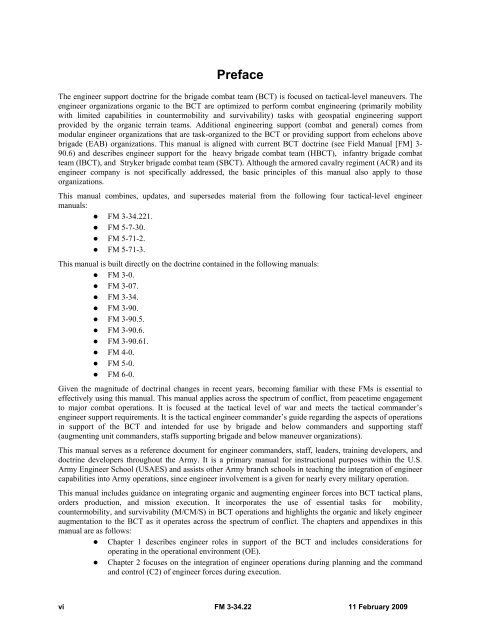FM 3-34.22 - Army Electronic Publications & Forms - U.S. Army
FM 3-34.22 - Army Electronic Publications & Forms - U.S. Army
FM 3-34.22 - Army Electronic Publications & Forms - U.S. Army
Create successful ePaper yourself
Turn your PDF publications into a flip-book with our unique Google optimized e-Paper software.
Preface<br />
The engineer support doctrine for the brigade combat team (BCT) is focused on tactical-level maneuvers. The<br />
engineer organizations organic to the BCT are optimized to perform combat engineering (primarily mobility<br />
with limited capabilities in countermobility and survivability) tasks with geospatial engineering support<br />
provided by the organic terrain teams. Additional engineering support (combat and general) comes from<br />
modular engineer organizations that are task-organized to the BCT or providing support from echelons above<br />
brigade (EAB) organizations. This manual is aligned with current BCT doctrine (see Field Manual [<strong>FM</strong>] 3-<br />
90.6) and describes engineer support for the heavy brigade combat team (HBCT), infantry brigade combat<br />
team (IBCT), and Stryker brigade combat team (SBCT). Although the armored cavalry regiment (ACR) and its<br />
engineer company is not specifically addressed, the basic principles of this manual also apply to those<br />
organizations.<br />
This manual combines, updates, and supersedes material from the following four tactical-level engineer<br />
manuals:<br />
� <strong>FM</strong> 3-<strong>34.22</strong>1.<br />
� <strong>FM</strong> 5-7-30.<br />
� <strong>FM</strong> 5-71-2.<br />
� <strong>FM</strong> 5-71-3.<br />
This manual is built directly on the doctrine contained in the following manuals:<br />
� <strong>FM</strong> 3-0.<br />
� <strong>FM</strong> 3-07.<br />
� <strong>FM</strong> 3-34.<br />
� <strong>FM</strong> 3-90.<br />
� <strong>FM</strong> 3-90.5.<br />
� <strong>FM</strong> 3-90.6.<br />
� <strong>FM</strong> 3-90.61.<br />
� <strong>FM</strong> 4-0.<br />
� <strong>FM</strong> 5-0.<br />
� <strong>FM</strong> 6-0.<br />
Given the magnitude of doctrinal changes in recent years, becoming familiar with these <strong>FM</strong>s is essential to<br />
effectively using this manual. This manual applies across the spectrum of conflict, from peacetime engagement<br />
to major combat operations. It is focused at the tactical level of war and meets the tactical commander’s<br />
engineer support requirements. It is the tactical engineer commander’s guide regarding the aspects of operations<br />
in support of the BCT and intended for use by brigade and below commanders and supporting staff<br />
(augmenting unit commanders, staffs supporting brigade and below maneuver organizations).<br />
This manual serves as a reference document for engineer commanders, staff, leaders, training developers, and<br />
doctrine developers throughout the <strong>Army</strong>. It is a primary manual for instructional purposes within the U.S.<br />
<strong>Army</strong> Engineer School (USAES) and assists other <strong>Army</strong> branch schools in teaching the integration of engineer<br />
capabilities into <strong>Army</strong> operations, since engineer involvement is a given for nearly every military operation.<br />
This manual includes guidance on integrating organic and augmenting engineer forces into BCT tactical plans,<br />
orders production, and mission execution. It incorporates the use of essential tasks for mobility,<br />
countermobility, and survivability (M/CM/S) in BCT operations and highlights the organic and likely engineer<br />
augmentation to the BCT as it operates across the spectrum of conflict. The chapters and appendixes in this<br />
manual are as follows:<br />
� Chapter 1 describes engineer roles in support of the BCT and includes considerations for<br />
operating in the operational environment (OE).<br />
� Chapter 2 focuses on the integration of engineer operations during planning and the command<br />
and control (C2) of engineer forces during execution.<br />
vi <strong>FM</strong> 3-<strong>34.22</strong> 11 February 2009

















